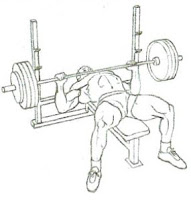 |
| Muscle Growth Stories - Bench Press |
Step 2 - Keep the number of reps low (6 - 10 reps)
In your workouts you should activate the strength and speed muscle fibers, not the endurance ones. If your goal is to grow muscles, than you should keep the repetition range within this limit. What does it mean? Studies proved that a normal athlete that at 100% capacity will do 1 repetition, will perform at 60% capacity 14 reps. For example, if you're maximum weight with which you can do 1 single bench press is 200 pounds, you will probably do 14 reps using 120 pounds. So keeping repetition range between 6 - 10, will help you see results faster.
Step 3 - Allow your body to recharge the fuel between the sets.
 |
| Muscle Growth Stories - Muscle Refuel |
Step 4 - Alternate the exercises.
Every exercise has a certain lifespan. For example, let's say you want to train chest. If you start and you do push ups, at the beginning its a very useful exercise, very low risk. However, initially you are training the strength and speed fibers, and after a period you will train the endurance fibers, because your muscles already get used with the stress level. That happens when you go over 14 reps with the push-ups. That means that exercise life span has ended. Next step is to move to another exercise where you can add more resistance. An exercise that has unlimited life span is the barbell flat bench press (chest press). In this case, once your reach the limit, you always can add more weight.
Step 6 - Use age in your advantage
Maybe you believe that if you are 50 years old you cannot grow your muscles. It all depends on the testosterone level. If the level is low, you will not be able to increase the size, but you can develop the strength. It takes a little bit more time, but it can still be done. Starting at an early age is not recommended, but there were exceptions that proved that is possible.